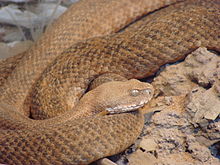- Macrovipera schweizeri
-
Macrovipera schweizeri Conservation status Scientific classification Kingdom: Animalia Phylum: Chordata Subphylum: Vertebrata Class: Reptilia Order: Squamata Suborder: Serpentes Family: Viperidae Subfamily: Viperinae Genus: Macrovipera Species: M. schweizeri Binomial name Macrovipera schweizeri
(Werner, 1935)Synonyms - [Vipera lebetina] schweizeri - Werner, 1935
- Vipera lebetina schweizeri - Mertens, 1951
- Vipera lebetina siphnensis - Wettstein, 1952
- Daboia (Daboia) lebetina schweizeri - Obst, 1983
- D[aboia]. l[ebetina]. schweizeri - Engelmann et al., 1985
- Vipera schweizeri - Nilson & Andrén, 1988
- Vipera lebetina schweizeri - González, 1991
- Macrovipera schweizeri - Herrmann, Joger & Nilson, 1992[1]
Macrovipera schweizeri is a venomous viper species found in Greece on the islands of the Cyclades Archipelago in the Aegean sea. No subspecies are currently recognized.[4]
Contents
Description
Grows to an average length of 50-70 cm, with a maximum of 98.5 cm.[2]
Geographic range
The Grecian islands of the Cyclades Archipelago in the Aegean Sea: Milos and the three smaller, adjacent islands of Siphnos, Kimolos and Poliaigos.[1][2] The type locality is given as "Insel Milos."[1]
Conservation status
This species is classified as Endangered (EN) according to the IUCN Red List of Threatened Species with the following criteria: B1ab(iii,v) (v3.1, 2001).[5] This indicates that the extent of its occurrence within its geographic range is estimated to be less than 5,000 km², that its populations are severely fragmented or known to exist at no more than five locations. Furthermore, a continuing decline is observed, inferred or projected in the area, extent and/or quality of habitat, as well as the number of mature individuals.[6]
So listed because its extent of occurrence is, in fact, not much greater than 100 km² -- it is known from only four small islands. There is continuing decline in the extent and quality of its habitat, and it is experiencing a decline in the number of mature individuals due to persecution and over-collecting. Year assessed: 2005.[5]
It is also listed as strictly protected (Appendix II) under the Berne Convention.[7]
See also
- List of viperine species and subspecies
- Viperinae by common name
- Viperinae by taxonomic synonyms
- Snakebite
References
- ^ a b c McDiarmid RW, Campbell JA, Touré T. 1999. Snake Species of the World: A Taxonomic and Geographic Reference, vol. 1. Herpetologists' League. 511 pp. ISBN 1-893777-00-6 (series). ISBN 1-893777-01-4 (volume).
- ^ a b c Mallow D, Ludwig D, Nilson G. 2003. True Vipers: Natural History and Toxinology of Old World Vipers. Krieger Publishing Company, Malabar, Florida. 359 pp. ISBN 0-89464-877-2.
- ^ Steward JW. 1971. The Snakes of Europe. Cranbury, New Jersey: Associated University Press (Fairleigh Dickinson University Press). 238 pp. LCCCN 77-163307. ISBN 0-8386-1023-4.
- ^ "Macrovipera schweizeri". Integrated Taxonomic Information System. http://www.itis.gov/servlet/SingleRpt/SingleRpt?search_topic=TSN&search_value=634979. Retrieved 9 August 2006.
- ^ a b Macrovipera schweizeri at the IUCN Red List. Accessed 2 September 2007.
- ^ 2001 Categories & Criteria (version 3.1) at the IUCN Red List. Accessed 2 September 2007.
- ^ Convention on the Conservation of European Wildlife and Natural Habitats, Appendix II at Council of Europe. Accessed 9 October 2006.
External links
- Macrovipera schweizeri at the Reptarium.cz Reptile Database. Accessed 2 September 2007.
- Cyclades blunt-nosed viper (Macrovipera schweizeri) at ARKive. Accessed 26 September 2006.
- Macrovipera schweizeri at Amphibians and Reptiles of Europe. Accessed 9 October 2006.
Categories:- IUCN Red List endangered species
- Viperinae
Wikimedia Foundation. 2010.


